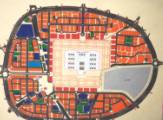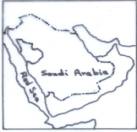The House of Al-Madina Al-Monawarah
(An
Expression of Place Identity in Saudi Arabia)
|
Short
Lead The
city of Al-Madina Al-Monawarah Ė the second religious Islamic
center represents one of Moslem cities that have been affected
by socio/economic changes that took place during last decades.
These changes had direct impact on the urban form of Al-Madina,
and itís social structure as well. Research
Objective This
research aims to study how the house of Al-Madina Al-Monawarah
expresses the socio/economic changes in new forms and patterns.
The house will be used as a tool to have answers to the question:
Does the information society bring a new pattern of segregation,
and new methods of
peopleís communication . 1.
General Background of Al-Madina Al-Monawarah Basic information
about Al-Madina such as geographic on itís location, housing population
and climate data on itís may be essential to understand the context
within which the study lies. 1-1
Site:
It
includes a spacious area from vertical lines 36.30˚ to 42.15˚
east, and horizontal lines from 22.30˚ to 27.30˚ north.
(1) From three sides, North, West North, and West,
mountains surround Al-Madina, which give it a dry desert climate
(Figure 1) 1-2
Population: The population of Al-Madina Al-Monawarah has been increased specially in the last 30 years to reach 839000 people in 1999 (1). This increase in population was also accompanied by a growth in the number of Al-Madina visitors (Pilgrims and Omra visitors). Statistics show that in 1977, the number of Pilgrims at Al-Madina during the period before and after Haj (about two months) reached 1,073,061 people, while the number of Omra visitors reached 1,720, 868 around the year. (4) |
1-3
Urban Evolution: The
city of Al-Madina Al-Monawarah has traditionally centred around
the Mosque of Prophet Mohammed (Peace Be Upon Him. In the early
days, shops were also located nearby the homes, in a homogeneous
urban fabric. The Madina pilgrims and visitors service represent
the major part of the peopleís economic base.. During recent decades,
a series of dramatic change have taken place, and accelerated
the expansion of Al-Madinaís urban settlement. These changes are: -
The economic growth that happened are due to the oil exploration,
in addition to the rapid acceleration of oil price especially
after the October war in 1973. - The development
of all means of communication, and transportation: automobiles,
air plane, telephones and now space satellites and computer networks
have made nearly everywhere accessible to anywhere else. -
The expansion of the Mosque of Prophet Mohammed (Peace Be Upon
Him). It was enlarged from 10 000 m2 in the year 1951
to be about 370 000 m2 in the year 1993. -
The huge housing project in
the center of Al-Madina,
which aims, to generate housing units for 300
000
persons (Figure 2). To achieve this goal; the whole old city has
been demolished (Figure 3).
 (Figure2)  (Figure3) 1-4)
New Social and Urban Pattern: As
consequence of these changes, new suburban centers have emerged
from the old city. New patterns
of social life has begun. Madinians
have missed the coherent relationship with their old city. This
also includes their participation in daily commercial activities which were left in most cases to cheap foreign nationals. As
the economic status of most residents of these new sub-centers
has improved, the new prestigious physical and spatial requirements
have appeared. Correspondingly, the house as the unit of these
new housing settlements has expressed itself through new forms
and facets. |
